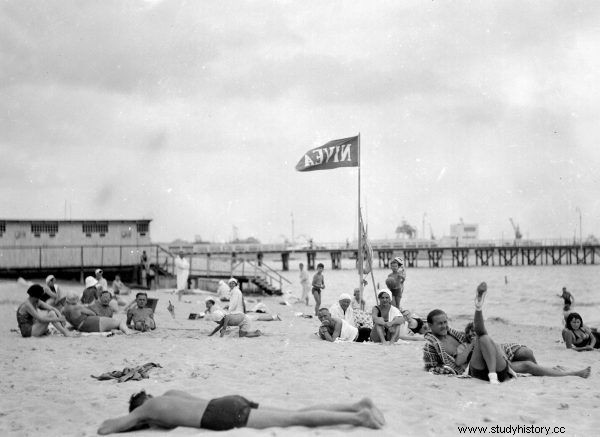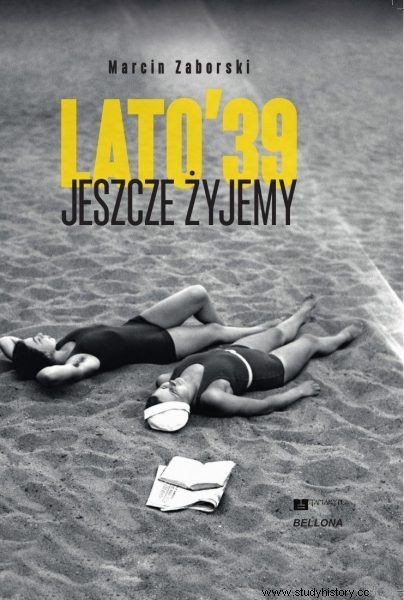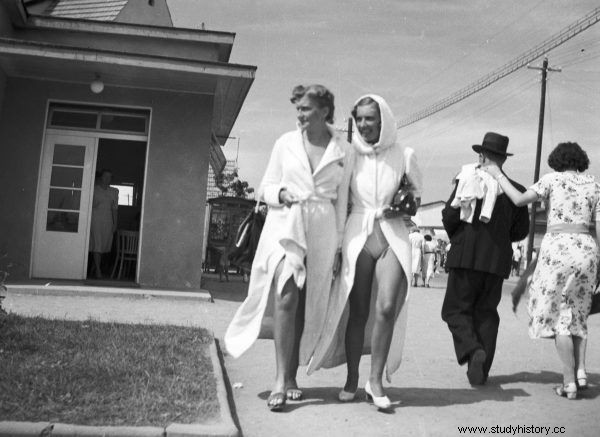Rows of screens and piles of rubbish are nowadays a gloomy everyday life on seaside beaches. 80 years ago the situation did not look any better, although our great-grandparents struggled with slightly different problems. Fighting with nudity, wicker baskets and sunbathing according to instructions - what was the pre-war beaching like?
In the summer of 1939, the Baltic beaches experienced a real siege. In the second half of June, the heat attracted hordes of tourists who wanted to take a refreshing bath and experience the attractions of coastal towns.
Summer vacationers had a lot to choose from:resorts were intensively expanded, and a giant hotel for over six hundred guests was to be built soon in Jastrzębia Góra. Jastarnia offered numerous guesthouses and cottages for rent, as well as a completely new Spa House, where visitors were crowded every evening trampling the dance floor of the dance hall.
In places previously neglected and littered, there were beautiful gardens, reserves and tree-lined avenues. On the Hel Peninsula, you could admire rare species of dune plants, in Jastarnia - a rosarium, and in Chałupy - charming, shaded nooks. Overnight in this "paradise on earth" cost from about three and a half to six zlotys per night.
This is not a beach for old people
This idyllic picture of a pre-war seaside holiday seems almost too beautiful to be true. Because were Polish beaches just before the outbreak of the war really so idyllic, as if taken straight from a movie? In the book "We are still alive. Summer '39 "Marcin Zaborski argues that not entirely ... After all, tourists rested there, and as it is well known, where holidaymakers, there is an argument ...

Before the war, the Baltic Sea was a popular holiday destination for Poles. In the 1930s, the beaches were full of representatives of all social strata.
And indeed! Reading the pre-war press provides extremely interesting information on what was happening in popular resorts. The newspapers of that time received numerous letters from holidaymakers who could not remain indifferent to the lack of taste and excessive exposure to other people on the beaches. Interestingly, the self-proclaimed guardians of fashion and good taste were not outraged by the increasingly cut, tight swimwear themselves. The problem arose when this type of outfit was worn by ladies with too much body weight or simply ... older ones.
Attention was also paid to inept and unsightly attempts to hide the age under thick layers of makeup. One reader of "Dziennik Bydgoski" quite emphatically concluded his letter about the "beach scar":
Does the Polish society with a healthy and moral thinking to these symptoms of disgusting and hideous demoralization among our ladies do not react? It is generally said that this "fashion" dictates, so you have to end this "fashion" as soon as possible, because it only wreaks moral decay among the most beautiful and subtle human beings .
As early as 1933, attention was drawn to this ugly trait of Poles, outraged by someone else's corporeality. In the women's supplement to the magazine "Nowy Czas" it was written:"On the beaches of large cities and bathing places we meet women of all ages. […] A gray head in a swimming pool, on a bicycle or a slide makes a sensation when it does not pay attention in other countries ”. What was the reason why such trends appeared among holidaymakers on the Vistula? It's hard to say…
Today, farmers and workers who have seen the sea for the first time would probably attract more attention. And more and more of these appeared! Ultimately, in the 1930s, the Baltic Sea became a place of summer pilgrimages not only for the wealthy - in the months just before the war, resorts were bursting at the seams with representatives of all social classes.

Many of those new to the seaside did not undress at all, despite the heat of over forty degrees. Covered from head to toe, they simply sat for days, enjoying the sight of the "great water", not disturbing anyone. Sometimes they just poured dry sand from hand to hand…
The law says:get dressed!
Meanwhile, in Druskininkai on the Nemunas it happened that a large group of holidaymakers were fined with fines in the amount of one zloty. For what? The ladies, returning from the bathing beach, did not fasten their coats and paraded along the streets of the city, showing passers-by a little more than the then social norms allowed.
The author of the article on this topic, which appeared in the "National Voice", clearly emphasized that the vicious women were "of commercial religion" (which simply means that they were Jewish), and the punishment "did not stop the efforts of exhibitionist daughters Zion ” . Finally, he hoped that the consequences of similar behavior would be more severe in the future.
In a way, however, the negligee exterminators can be understood. Ultimately, the interwar period was a turning point for women's fashion. It was possible to go to the beach in an outfit revealing the whole legs, which, however - like every change - was offensive to the more sensitive audience. Hence regular battles fought in the name of morality, against liberation and the demonstration of charms. And so, for example, in August 1933 in "Nowy Czas", he reported a downward trend in the amount of material allocated to making a costume:
[Costumes - ed. ed.] decrease to a minimum or even completely disappear, especially when you sunbathe in places slightly exposed by coastal bushes . Admittedly, it is strictly forbidden, so that even the police officer looks at the swimming pool protruding over the river, or the ladies sunbathing there, not worse by the excessive undressing of passing canoeists and passengers of Vistula ships.

You could get a fine for walking in an unbuttoned bathrobe.
The beach excesses did not always end with the mandate. Marcin Zaborski in the book “We are still living. Summer '39 ”describes a moral conflict that only ended in court! The accusatory was a vacationer spending her vacation on the river Serwecz near Budzisław.
She had an argument with another (male) vacationer who at one point told her to leave the beach. When she disagreed, arguing that there would be enough water and sand for everyone, he chased her away ... taking off his bathing trunks. The woman ran away and then filed a lawsuit accusing the man of scandalous behavior.
Trash instead of a screen
Forests of screens haunt the present-day Baltic beach. It used to be a bit different - but just as bizarre. Before the war, wicker "beach baskets", invented in 1845 by Wilhelm Bartelman, were a popular way to separate oneself from the rest of sunbathers. The original design was of course improved, so that in the interwar period tourists could choose from a variety of models with numerous amenities.
Some had tilt roofs, others had sophisticated seats, footrests or doors. Folding tables were also installed for convenience. On the other hand, the side windows common in many models were used to ... watch the neighbors . What kind of vacation is it if you can't get a good look at other people's outfits and behavior?

Before the war, beach baskets were extremely popular - some models were equipped with side windows to watch the neighbors.
As Dr. Józef Pluciński emphasizes, this is exactly what these wicker constructions were for. Thanks to this, men could imperceptibly observe the passing ladies, while their better halves had a chance to hide in the shadows and, for example, crochet or stealthily follow the latest trends in beach fashion "live".
Although the idea of a beach basket seems to be somewhat impractical now (unlike a screen, it cannot be folded; it also does not allow for "marking out" a large "plot" in the sand), in the 1920s and 1930s they were used very commonly also in Poland.
The beach in Świnoujście was literally littered with larger and smaller wicker boxes. Their owners quickly understood that renting out places on the beach was an excellent seasonal business, and already in 1930 on the Baltic Sea one could count over 15,000 "secluded" positions available for a fee.
Tanning instruction
Along with the fashion for sunbathing, the society has also mastered the mania of sunbathing. It's just that people didn't really know how much they could afford - and what the consequences would be if they overdo it with sunbathing. Doctors by no means helped by bombarding hapless beach-goers with strange information. The advice was often quite sane, but the complexity of it could make you dizzy.
And so in the magazine "Bluszcz" it was suggested to sunbathe between 9 and 12, preferably not lying down, but walking in the sun. On the first day, no more than 10 minutes and only the legs and arms. The next one could be exposed to sunlight for the whole body, but only for a quarter of an hour . The author of the article ensured that the appropriate "dosage" ultimately allows for 2- or even 3-hour sessions!

It was absolutely forbidden to sunbathe or take a bath after eating! According to the specialist of "Bluszcz", one had to wait an hour and a half from the last meal before going to the beach. And after sunbathing - a shower at a temperature of 20-25 degrees Celsius is obligatory and a half-hour rest in a shaded place without drafts. Further recommendations are listed by Marcin Zaborski in the book "Still living. Summer '39 ":
And so that tanning does not end with unpleasant consequences, we must not forget about preparations that will help us protect and nourish the skin exposed to the sun. For blondes with delicate skin, the best option is to use olive oil on it and washing with cold water. In turn, blondes with oily skin should rub it with a hormone cream. Otherwise, brunettes - slightly astringent products will be perfect for them .
However, has so much changed so far? After all, today there will always be someone who has dressed or undressed not as we would like (although we do not write indignant letters to the newspapers on this matter and do not sue for insulting morality). The wicker basket has turned into a screen, but it's actually a minor difference. The beaches - just like before the war - are crowded. And one more thing remained the same:despite the best intentions and "golden advice", the sun often burns instead of sunbathing. The author of the satirical song published in the July 1930 issue of "Troubadour of Warsaw" put it perfectly:
[…] Long live the beach that creates delight
Though a man burns himself like bread in an oven,
But she is seduced, because girls,
This is an incentive, so you stick to it.
Bibliography:
- B. Końskowolski, On the beach, "Trubadur Warszawy", No. 29, July 1930.
- The woman on the beach. Old age and youth. Health and entertainment, "New Time" R.3, No. 233, August 24, 1933.
- J. Pluciński, The Beach Basket and His Amazing Career, iswinoujscie.pl (accessed on 7/9/2019).
- M. Zaborski, We're still alive. Summer '39 , Bellona 2019.
Check where to buy “We're still alive. Summer '39 ":
